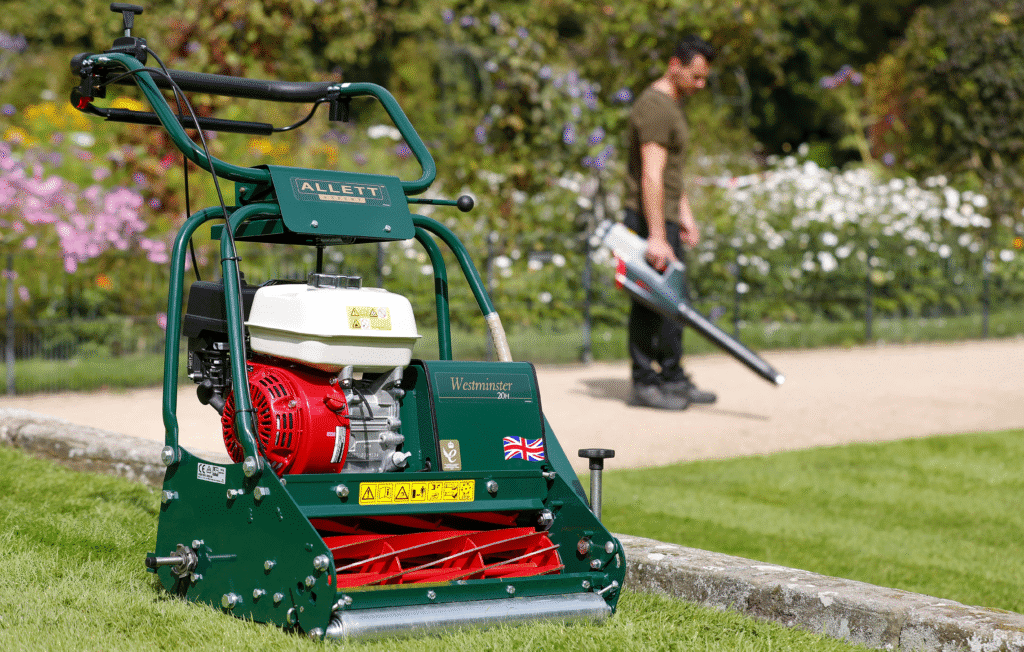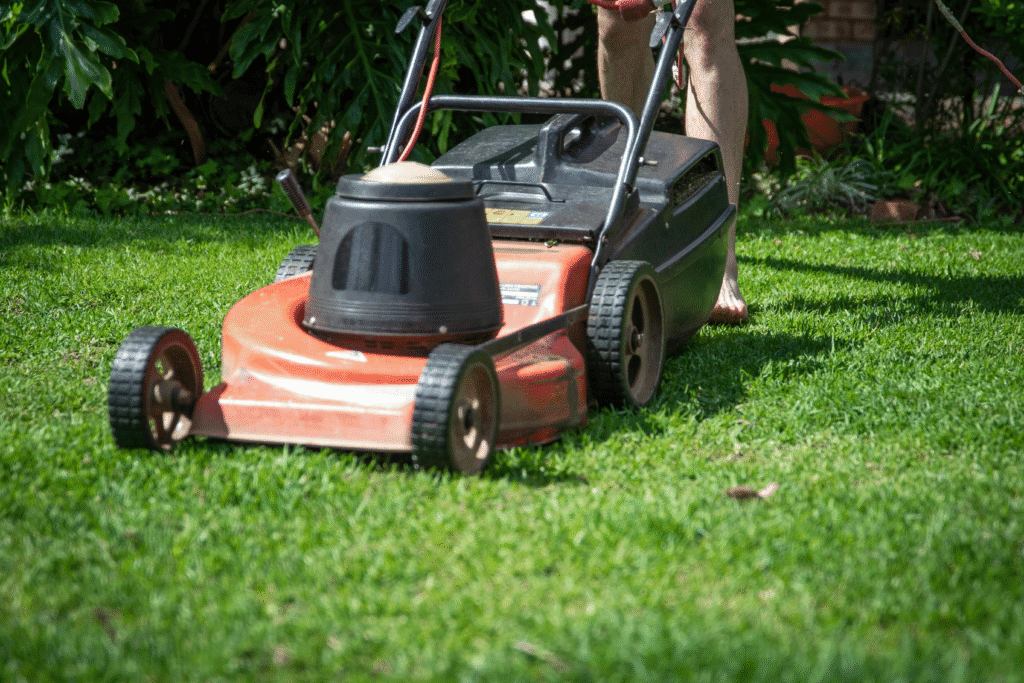You know the feeling of a freshly cut lawn, right? The aroma is wonderful; it’s so pleasant. That’s breathtaking; the artistry is incredible. But what keeps that cutting machine purring, allowing you to effectively cut grass all season?
Consistent lawn mower maintenance is a huge part of it. Neglecting your mower, whether it’s a simple push mower or a more complex riding model, is like asking for trouble and a patchy yard. This routine mower care gives you that perfect cut, season after season, and is fundamental to good lawn care.
Taking a little time for lawn mower maintenance now saves you a lot of headaches later. Think about it; your mower works hard for you. So, giving it some attention isn’t just a chore; it’s an investment in a beautiful lawn and a longer life for your trusty machine, keeping your equipment power optimal.
You’ll be glad you did when it starts up on the first pull next spring, ready for all your lawn mowing needs. Proper maintenance also means your mower starts easily every time.
Ready to begin? Here’s the plan:

- Lawn mower maintenance: Is it worth the effort? You bet it is! A well-maintained mower runs better and lasts longer.
- When is the Best Time for Lawn Mower Maintenance?
- Your Essential Lawn Mower Maintenance Checklist
- Get to Know Your Owner’s Manual
- Safety First: Disconnect the Spark Plug
- Fuel System Care: Old Gas Out, Stabilizer In
- Oil Change Time: Keeping the Engine Happy
- Breathe Easy: Clean or Replace the Air Filter
- Sharp Blades, Clean Cuts: Blade Sharpening and Balancing
- Clean Machine: The Undercarriage and Deck
- Engine Protection: Consider Fogging the Engine (for Winter Storage)
- More Lawn Mower Maintenance Tips for Success
- DIY or Call a Pro for Lawn Mower Maintenance?
- We’ve arrived. This is the moment. The final word.
Lawn mower upkeep: Is it worth the effort? You bet it is!
So, why add another task to your list of chores? You’ll find that taking care of your lawn mower directly impacts how easy it is to keep your lawn looking sharp. Don’t let your yard get overgrown. Regular maintenance keeps it beautiful and easy to manage; it’s a simple solution to a common problem. Your mower could last 10 to 15 years with proper care, especially if you follow routine mower maintenance schedules.
Without it, you might be shopping for a new one much sooner, a situation that impacts both your wallet and your lawn care routine. Regular check-ups, part of thorough mower care, help your equipment power through the season. This attention also keeps the mower engine running smoothly and efficiently.

This means it uses fuel better and puts less stress on the mower engine parts. A well-maintained mower also cuts grass cleanly, without leaving unsightly grass clippings bunched up or causing damage to the grass blades. Such proactive care can prevent the need for more serious mower repair down the line.
Dull or damaged blades tear grass, which makes your lawn look ragged and stressed. Torn grass is also more open to diseases, compromising the health of your spring lawn. Sharp, balanced blades, on the other hand, give you that neat, carpet-like finish we all love, making lawn mowing a more satisfying task.
A healthy lawn can really bounce back from anything. And there’s a safety part too; for safety reasons, regular checks are important. Regular mower maintenance is super important. Checking for loose parts and wear and tear can stop accidents before they happen.
Proper lawn mower maintenance keeps everything working as it should, helping your machine run smoothly and reliably. Performance problems? They often start with simple things like a clogged fuel filter or bad spark plugs, easily avoided with regular maintenance. Think of it like brushing your teeth—you wouldn’t skip that, right? Proper mower maintenance keeps it running smoothly, so you’re always ready to mow.
When is the Best Time for Lawn Mower Maintenance?
Proper timing really boosts your lawn mower maintenance. You can perform these maintenance steps any time. But, some moments are better than others for specific maintenance tasks.
Many people service their mowers before the first cut of spring, ensuring their spring lawn mower is prepared. This makes sense because you want your mower ready to tackle that first spring lawn growth. Another great time is at the end of the mowing season, when you’re packing it away for winter, which helps ensure your mower starts without issue next year.
The exact timing can shift a bit depending on where you live and the type of lawn mowers you own. In some places, grass grows fast all summer long, requiring more frequent mowing. Your maintenance schedule needs to adjust for this. Doing maintenance in the fall, before storage, is super smart, especially for tasks like cleaning the fuel tank.
You can fix any issues from the past season and also prepare it for sitting idle for months. This way, when spring pops up, your mower is raring to go, and you are ready to start mowing. Consider consulting your local urban regional extension for climate-specific advice; sometimes an extension agent from an urban regional extension office can provide tailored tips.
You won’t face delays from a sputtering engine or damage from dull blades if you’re proactive. Prepping it before winter means fewer surprises and a reliable machine when it’s time to mow again. Proper mower maintenance avoids a whole lot of aggravation.
Your Essential Lawn Mower Maintenance Checklist
Feeling a bit overwhelmed by the prospect of lawn mower maintenance? Don’t be. Here’s a straightforward checklist of essential maintenance tasks. Proper lawn mower care is simple. A few basic maintenance steps will keep your mower working great and prevent costly repairs down the road.
Following these maintenance tips will keep your equipment in prime condition. These steps are the base of a good lawn mower maintenance plan. Following them keeps your mower running smoothly. We’ll go over the key maintenance steps now.
| Maintenance Task | Frequency / When to Perform | Key Benefits |
|---|---|---|
| Read Owner’s Manual | Before first use & as needed | Understand specific model needs, safety, and procedures. |
| Disconnect Spark Plug | Before any maintenance | Prevents accidental starting and injury. |
| Fuel System Care | End of mowing season / Before long storage | Prevents stale fuel issues, gumming, and starting problems. |
| Change Engine Oil | Seasonally or per manual (e.g., 25-50 hours) | Lubricates engine, prevents wear, keeps engine running smoothly. |
| Clean/Replace Air Filter | Regularly (e.g., every 25 hours or seasonally) | Ensures proper airflow, engine efficiency, and prevents damage. |
| Sharpen & Balance Blades | 1-2 times per season or as needed | Provides a clean cut, healthier lawn, reduces engine strain. |
| Clean Undercarriage/Deck | After each use or regularly | Prevents rust, improves airflow and cutting performance. |
| Fog Engine (Winter Storage) | Before extended winter storage | Protects internal engine parts from corrosion. |
| Check Tire Pressure (Riding Mowers) | Monthly or before each use | Ensures even cut, stability, and proper handling. |
| Inspect Belts | Monthly or as per manual | Prevents unexpected breakage and performance loss. |
Get to Know Your Owner’s Manual

Before you touch a single bolt or perform any lawn mower repair, find that owner’s manual. Seriously. Lawn mower maintenance just got easier. Get the most out of your mower with this guide—it’s full of useful information, perfectly matched to your model.
Every mower model, from different lawn mowers brands, can have its own little quirks and specific needs. The manufacturer provides instructions for a reason; they want your mower to last and perform well for all your cutting grass needs. It’s the first step to properly maintain lawn mower effectiveness.
Listen to them; you’ll avoid mishaps. It tells you the right parts, the right fluids like specific engine oil, and the right way to do things, specific to your equipment power. Keep this guide close by while you’re taking care of your mower.
Safety First: Disconnect the Spark Plug
This step is absolutely critical for your safety. Before starting any lawn mower maintenance, disconnect the spark plug wire and, if possible, remove the spark plugs. This prevents the mower engine from accidentally starting while you’re working on it.
This little action? Oh, *this*. A real game changer. Seriously. You’ll likely replace spark plugs annually anyway, as good spark plugs help your mower start easily and contribute to the engine running smoothly. Worn spark plugs can cause starting issues and poor fuel economy.
But for safety during maintenance, just pulling the wire off the plug is vital. Or, even better, remove the plug completely if you’re comfortable doing so, especially before working near the blades. This is a non-negotiable part of safe mower care.
Fuel System Care: Old Gas Out, Stabilizer In
Old gasoline is a common reason mowers won’t start in spring. Gas can go stale in as little as 30 days, especially ethanol-blended fuels. Stale fuel can gum up the carburetor, fuel lines, and even the fuel filter, impacting the fuel tank integrity over time.
This creates a real mess and a non-starting mower. At the end of the mowing season, dealing with the fuel tank contents is a primary concern for your routine mower. You have two good choices for handling leftover fuel.
You can run the mower until the fuel tank is empty. Or, you can carefully drain the remaining fuel into an approved container for appropriate disposal or use in other equipment if fresh. If you plan to store fuel in the mower for more than a month, add a quality fuel stabilizer to fresh gas in the fuel tank.
Then, run the engine for a few minutes to circulate the stabilized fuel through the system. Start the spring with fresh gasoline for smooth operation and ensure the fuel filter is clean or replaced if necessary. This routine mower check prevents clogs and keeps the engine running smoothly.
Oil Change Time: Keeping the Engine Happy
Engine oil is the lifeblood of your mower’s engine. Think of it as a multi-tasker: it lubricates, cools, and cleans. This keeps everything working efficiently. Just like your car, your lawn mower needs regular oil changes using the correct type and grade of engine oil.
Refer to your owner’s manual; it will specify the correct type of oil (e.g., SAE 30, 10W-30) and the change procedure for your mower engine. Using the wrong oil can damage your engine. Change the oil if it’s old, dark, or contaminated with dirt and debris.
Typically, this is done once a season or after a specified number of operating hours (often 25-50 hours). Draining old engine oil and replacing it with new, clean oil is vital lawn mower maintenance. Remember to dispose of used oil properly; never pour it down a drain or on the ground.
Most local auto shops, service stations, or municipal recycling centers accept used oil. Responsible lawn care includes getting rid of used oil the right way. This protects the environment. A well-lubricated engine means your mower starts easier and runs more efficiently.
Breathe Easy: Clean or Replace the Air Filter

Your mower’s engine needs a consistent supply of clean air to mix with fuel for efficient combustion. A dirty or clogged air filter, one of the crucial air filters in your machine, restricts airflow. This can cause the engine to run rough, lose power, emit black smoke, and use more fuel.
It’s a simple but important part of lawn mower maintenance to check air filter status regularly, ideally before each use or every few uses. Your manual will show you how to locate and service it. A quick check air filter procedure can save you from bigger problems.
Some mowers have paper air filters that need replacement when dirty to keep the filter clean. Others have foam air filters you can wash with detergent and water, allow to dry completely, and then re-oil lightly with clean engine oil. A clean air filter keeps your mower’s engine running smoothly. This helps your mower perform at its peak.
Keeps damaging dust, dirt, and grass clippings out of the mower engine. Prolonging your engine’s life and keeping its performance high is easier than you think. A bit of routine maintenance is all it takes. Proper engine care is an investment. It pays off in the long run with fewer repairs and a longer-lasting engine; this translates to lower costs and less stress for you. Always ensure the filter clean practices are followed as per manufacturer guidelines.
Sharp Blades, Clean Cuts: Blade Sharpening and Balancing
Your mower blades do the tough work of cutting grass. Fast spinning means collisions with all sorts of debris are unavoidable, even when you try to steer clear of rocks and sticks. Over time, they will inevitably get dull, chipped, or bent.
Dull blades tear grass instead of cutting it cleanly. This stresses your lawn, makes it look unhealthy with ragged, brown tips, and increases its susceptibility to diseases. You can tell blades are dull if the grass tips look frayed after mowing.
You can sharpen blades yourself with a file, bench grinder, or a blade sharpening attachment for a drill, taking care to maintain the original cutting angle. However, it takes some skill to get the right angle and, crucially, to keep them balanced. Damaged engine parts, a ruined cutting deck, and a poorly cut lawn are all possible results of unbalanced mower blades. The vibrations from unbalanced blades are intense and cause a lot of damage.
Keeping your lawnmower in top shape is easier than you think. Professional blade sharpening and balancing pays off with a nicer lawn. Look up guides on how to sharpen lawn mower blades correctly if you decide to DIY these maintenance steps, and always wear heavy gloves and eye protection. Alternatively, consider purchasing a new blade if the old one is heavily damaged.
Clean Machine: The Undercarriage and Deck
Grass clippings, mud, leaves, and other debris love to cake onto the underside of your mower deck. Imagine this: moisture trapped against metal because of that mess. Rust and corrosion are the inevitable results. It’s not pretty. If airflow is blocked, the engine struggles, producing uneven cuts and a drop in performance. This puts extra stress on the whole system.
Regular cleaning is part of smart lawn mower maintenance. After each use, especially if the grass was wet, or at least regularly, clear out this gunk. A putty knife, wooden scraper, or a dedicated deck scraper works well for dried-on stuff; for stubborn buildup, some people use a pressure washer carefully, avoiding direct spray on bearings, seals, and the engine.
A brush and hose can also help effectively. Make absolutely sure the spark plug is disconnected, and the mower is cooled down before you tilt the mower (tilt it with the carburetor side up to prevent oil or fuel spillage) or reach underneath to maintain lawn mower safety. Some mowers have a washout port for easier cleaning.
Engine Protection: Consider Fogging the Engine (for Winter Storage)

If your mower will sit unused for an extended period, like during the winter months, this step is important for long-term mower care. Over time, lubricants inside the engine can drain away from cylinder walls, pistons, and rings. Moisture in the air, especially in damp storage environments, can then cause corrosion or rust on these bare metal surfaces.
This internal rust can lead to significant engine problems, such as seized rings or a damaged cylinder, when you try to start it next season. Fogging oil is a special aerosol spray designed for this purpose. It coats internal engine components with a thin, protective oily film, which helps keep the engine running smoothly when it’s started again.
Your owner’s manual will state if fogging is recommended for your specific mower engine and provide instructions. If so, follow the directions on the fogging oil can very carefully, which usually involves spraying it into the carburetor intake or spark plug hole while the engine is briefly running or being cranked. Regular maintenance prevents costly engine repairs and ensures effortless starts after storage. Imagine the frustration of a balky engine after months of inactivity – this simple step avoids that.
More Lawn Mower Maintenance Tips for Success
Beyond the annual checklist, a few ongoing habits contribute significantly to keeping your mower in peak condition. Every tiny piece contributes to the whole picture; don’t underestimate their power. Keep your lawn mower in top shape and your grass looking great with these simple maintenance tips.
Keeping your equipment running smoothly means paying attention to the little things. Stick with a regular maintenance schedule; it’s the best way to avoid bigger problems down the road. Following these habits will make mowing your lawn a breeze.
Regular Inspections are Your Friend
Don’t just wait for that big yearly tune-up as part of your routine mower care. Before each mowing session, give your machine a quick once-over. Give the handles, wheels, and engine a once-over. Are all the nuts and bolts secure?
Look for any damaged or worn parts, such as cracked housings or frayed cables, and check for any fluid leaks (oil or fuel). Clear away any sticks, toys, or other debris from the deck and the lawn area before you start mowing. This quick check, part of regular maintenance steps, can catch small problems.
It stops them from becoming big, expensive ones for your routine mower. Safety and reliability? You get two benefits here. Think of it like a seatbelt; it’s there to protect you. Regular, short inspections help your mower last longer.
Tire Pressure Matters (for Riding Mowers)
If you have a riding mower, lawn tractor, or even some larger walk-behind mowers with pneumatic tires, it is important to check tire pressure regularly. Low or uneven tire pressure can lead to an uneven cut, as one side of the deck might be lower than the other. This can make your mower wobbly, tougher to control, and guzzle more gas.
Your owner’s manual will list the recommended PSI (pounds per square inch) for your tires; it’s important to check tire conditions too, looking for cracks or damage. A few minutes with an air pressure gauge and an air pump can make a surprising difference to performance and cut quality. This simple check ensures your lawn mower maintenance, including a quick check tire pressure step, leads to the best possible cut and a more comfortable ride.

Properly inflated tires also reduce wear on the tires themselves and stress on the mower’s drivetrain. Don’t forget to check all tires, as they may have different pressure requirements. A little thing, easily missed, but crucial for best results. Think of it like the missing screw in a machine – everything can fall apart.
Belt Check (for Self-Propelled and Riding Mowers)
Many mowers, especially self-propelled walk-behinds and nearly all riding lawn mowers, use belts to transfer power from the engine to the drive wheels or the cutting blades. Rubber makes these belts tough, but friction, heat, and stress take their toll. They wear out eventually. Watch out for cracks, frayed areas, stretching, and glazed spots—regular maintenance prevents these problems and keeps things working smoothly.
A worn or damaged belt can slip, reducing cutting or driving performance, or it can break completely, leaving your mower inoperable. Regularly inspect the belts for signs of wear and tear, following the safety precaution of disconnecting the spark plug first. Make sure they have the proper tension, as noted in your manual for your specific lawn mowers; a belt that’s too loose will slip, and one that’s too tight can damage bearings.
Replacing a worn belt is much cheaper and easier than dealing with damage from a broken one or the inconvenience of a mid-mow failure. Boost your mower’s power for every cut! Just add this to your regular maintenance routine. Familiarize yourself with how to access and inspect these belts.
Proper Storage is Key
Where and how you keep your mower when it’s not in use matters significantly for its long-term mower care and health. Storing it in a clean, dry place protects it from the elements. A shed, garage, or dedicated storage unit is ideal for this purpose.
Protecting your mower from rust and corrosion is easy! Keep dirt, dust, and pests out of the engine and moving parts for a smooth start next season. If it must be stored outside, use a good quality, waterproof, and UV-resistant mower cover that fits well. Keeping it safe from the weather helps it last longer and look better.
Good storage complements all your other lawn mower maintenance efforts and helps maintain lawn equipment properly. Before long-term storage, clean the mower thoroughly and perform other seasonal maintenance tasks. This protects your investment and makes sure it’s ready when you next need to start mowing.
DIY or Call a Pro for Lawn Mower Maintenance?
Now, you might be thinking, “Can I do all this myself?” Many people absolutely can and do handle most lawn mower maintenance tasks. There’s a certain satisfaction in doing your own lawn mower maintenance for your push mower or riding mower, and it can foster a better understanding of your equipment.
It can save you some money on labor costs if you have the right tools, some basic mechanical know-how, and the time to dedicate to it. However, let’s be honest, some jobs can be messy, like changing oil or cleaning a very dirty deck. It can also take up a good chunk of your weekend, time you might prefer to spend elsewhere.
Some tasks, like precise blade sharpening and balancing, internal carburetor cleaning, or addressing complex engine issues, might require special tools or more advanced skills. If you’re not comfortable with certain procedures, lack the necessary tools, or simply don’t have the time, that’s perfectly okay; professional lawn mower repair services exist for these situations. Sometimes, for advice on general lawn care or equipment, your local urban regional extension, possibly with an extension agent like a ‘Marcus Garner’ if one serves your area, might offer resources, though specific mower repair is usually outside their scope.
Professional lawn mower service shops are there to help with your mower care needs. They have trained technicians, specialized diagnostic equipment, and access to genuine replacement parts to do a thorough and correct job. For more complex mower engine issues, transmission problems on riding mowers, or significant mower repair, a pro is often the best and safest bet.
Consider the complexity of your mower; newer models with advanced features might be more challenging for DIY work. Weigh the cost of tools and your time against the price of professional service. The most important thing is that the lawn mower maintenance gets done correctly and regularly, one way or another, ensuring your equipment power is always ready for cutting grass effectively and safely.

Simply put: that’s the core idea. Consider it finished.
Proper lawn mower care is surprisingly straightforward; a little upkeep goes a long way. With a little regular attention and proactive lawn mower maintenance, your machine can serve you well for many years to come. You can have a gorgeous, healthy lawn—easily and efficiently!
You’ll also save yourself from frustrating breakdowns, the high cost of unexpected lawn mower repair, and the inconvenience of a mower that won’t start. A well-maintained mower ensures the engine running smoothly and consistently. So, roll up your sleeves and apply these maintenance tips, or call a trusted service for your lawn care needs.
Your lawn (and your mower) will thank you for consistent lawn mower maintenance. Regular mower maintenance really pays off. Mow on!

